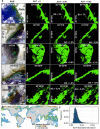Coastal phytoplankton blooms expand and intensify in the 21st century
- PMID: 36859547
- PMCID: PMC9995273
- DOI: 10.1038/s41586-023-05760-y
Coastal phytoplankton blooms expand and intensify in the 21st century
Abstract
Phytoplankton blooms in coastal oceans can be beneficial to coastal fisheries production and ecosystem function, but can also cause major environmental problems1,2-yet detailed characterizations of bloom incidence and distribution are not available worldwide. Here we map daily marine coastal algal blooms between 2003 and 2020 using global satellite observations at 1-km spatial resolution. We found that algal blooms occurred in 126 out of the 153 coastal countries examined. Globally, the spatial extent (+13.2%) and frequency (+59.2%) of blooms increased significantly (P < 0.05) over the study period, whereas blooms weakened in tropical and subtropical areas of the Northern Hemisphere. We documented the relationship between the bloom trends and ocean circulation, and identified the stimulatory effects of recent increases in sea surface temperature. Our compilation of daily mapped coastal phytoplankton blooms provides the basis for global assessments of bloom risks and benefits, and for the formulation or evaluation of management or policy actions.
© 2023. The Author(s).
Conflict of interest statement
The authors declare no competing interests.
Figures













Similar articles
-
Monitoring of ocean surface algal blooms in coastal and oceanic waters around India.Environ Monit Assess. 2014 Jul;186(7):4129-37. doi: 10.1007/s10661-014-3685-x. Epub 2014 Feb 20. Environ Monit Assess. 2014. PMID: 24554022
-
Marine harmful algal blooms (HABs) in the United States: History, current status and future trends.Harmful Algae. 2021 Feb;102:101975. doi: 10.1016/j.hal.2021.101975. Epub 2021 Mar 3. Harmful Algae. 2021. PMID: 33875183 Free PMC article. Review.
-
Harmful algal blooms and their effects in coastal seas of Northern Europe.Harmful Algae. 2021 Feb;102:101989. doi: 10.1016/j.hal.2021.101989. Epub 2021 Mar 6. Harmful Algae. 2021. PMID: 33875185
-
Variability patterns and phenology of harmful phytoplankton blooms off southern Portugal: Looking for region-specific environmental drivers and predictors.Harmful Algae. 2022 Jul;116:102254. doi: 10.1016/j.hal.2022.102254. Epub 2022 May 25. Harmful Algae. 2022. PMID: 35710203
-
Algal blooms historical outbreaks in the northern coastal waters of the Persian Gulf and Oman Sea (1980-2015).Environ Monit Assess. 2021 Sep 14;193(10):648. doi: 10.1007/s10661-021-09413-3. Environ Monit Assess. 2021. PMID: 34523030 Review.
Cited by
-
Warming and trophic structure tightly control phytoplankton bloom amplitude, composition and succession.PLoS One. 2024 Oct 4;19(10):e0308505. doi: 10.1371/journal.pone.0308505. eCollection 2024. PLoS One. 2024. PMID: 39365779 Free PMC article.
-
Pulse Feature-Enhanced Classification of Microalgae and Cyanobacteria Using Polarized Light Scattering and Fluorescence Signals.Biosensors (Basel). 2024 Mar 28;14(4):160. doi: 10.3390/bios14040160. Biosensors (Basel). 2024. PMID: 38667153 Free PMC article.
-
A lag bloom pattern of phytoplankton after freshwater input events revealed by daily samples during summer in Qinhuangdao coastal water, China.Front Microbiol. 2024 Jul 26;15:1454948. doi: 10.3389/fmicb.2024.1454948. eCollection 2024. Front Microbiol. 2024. PMID: 39132132 Free PMC article.
-
Harmful Algae Impacting Aquatic Organisms: Recent Field and Laboratory Observations.Toxins (Basel). 2023 May 15;15(5):339. doi: 10.3390/toxins15050339. Toxins (Basel). 2023. PMID: 37235374 Free PMC article.
-
Explainable deep learning identifies patterns and drivers of freshwater harmful algal blooms.Environ Sci Ecotechnol. 2024 Dec 27;23:100522. doi: 10.1016/j.ese.2024.100522. eCollection 2025 Jan. Environ Sci Ecotechnol. 2024. PMID: 39897111 Free PMC article.
References
-
- Anderson DM. Turning back the harmful red tide. Nature. 1997;388:513–514. doi: 10.1038/41415. - DOI
Publication types
MeSH terms
Grants and funding
LinkOut - more resources
Full Text Sources

